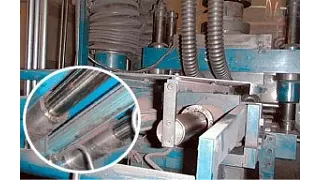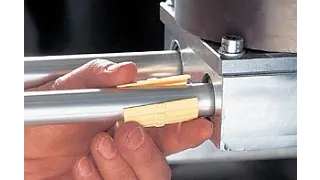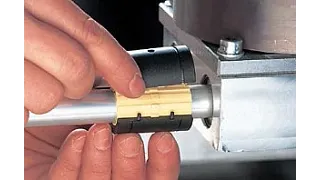Alterar idioma :
drylin® R - Technical information
Vídeo - Conheça a linha de guias lineares drylin® R
Nosso gerente de produto Anderson Batista apresenta à vocês nesse vídeo a linha completa de guias lineares drylin R, leves, silenciosas, robustas e livres de lubrificação!
Materials table
General specifications
Unit
iglidur® J
iglidur® X
iglidur® J200
Testing method
Density
g/cm³
1,49
1,44
1,72
Colour
yellow
black
dark grey
max. moisture absorption at 23°C/50% r.h.
% weight
0,3
0,1
0,2
DIN 53495
max. total moisture absorption
% weight
1,3
0,5
0,7
Coefficient of sliding friction, dynamic, against steel
µ
0,06 - 0,18
0,09 - 0,27
0,11 - 0,22
pxv value, max. (dry)
MPa x m/s
0,34
1,32
0,33
Mechanical properties
Flexural modulus
MPa
2.400
8.100
2.800
DIN 53457
Flexural strength at 20°C
MPa
73
170
58
DIN 53452
Compressive strength
MPa
60
100
43
maximum recommended surface pressure (20°C)
MPa
35
150
23
Shore D hardness
74
85
70
DIN 53505
Physical and thermal properties
max. long-term application temperature
°C
+90
+250
+90
max. short-term application temperature
°C
+120
+315
+120
min. application temperature
°C
-50
-100
-50
Thermal conductivity
[W/m x K]
0,25
0,6
0,24
ASTM C 177
Coefficient of thermal expansion (at 23°C)
[K-1 x 10-5]
10
5
8
DIN 53752
Electrical properties
specific contact resistance
Ωcm
> 1013
< 105
> 108
DIN IEC 93
Surface resistance
Ω
> 1012
< 103
> 108
DIN 53482
General specifications
Unit
iglidur® E7
iglidur® A180
Testing method
Density
g/cm³
1,05
1,46
Colour
dark grey
white
max. moisture absorption at 23°C/50% r.h.
% weight
0,1
0,2
DIN 53495
max. total moisture absorption
% weight
0,1
1,3
Coefficient of sliding friction, dynamic, against steel
µ
0,05–0,23
pxv value, max. (dry)
MPa x m/s
0,31
Mechanical properties
Flexural modulus
MPa
1.477
2.300
DIN 53457
Flexural strength at 20°C
MPa
22
88
DIN 53452
Compressive strength
MPa
78
maximum recommended surface pressure (20°C)
MPa
18
28
Shore D hardness
61
76
DIN 53505
Physical and thermal properties
max. long-term application temperature
°C
+70
+90
max. short-term application temperature
°C
+90
+110
min. application temperature
°C
-50
-50
Thermal conductivity
[W/m x K]
0,25
ASTM C 177
Coefficient of thermal expansion (at 23°C)
[K-1 x 10-5]
11
DIN 53752
Electrical properties
specific contact resistance
Ωcm
< 1012
DIN IEC 93
Surface resistance
Ω
> 109
< 1011
DIN 53482
DryLin® R - Comparison of the permitted dynamic loads with same diameter

X = speed v [m/s]
Y = F [N] Ø [mm]
A = unsupported shaft - steel/stainless steel
B = unsupported shaft - hard-anodized aluminum
C = supported shaft - steel/stainless steel
D = supported shaft - hard-anodized alum.
Figure 01: drylin® R - Comparison of the permitted dynamic loads with same diameter

Dirt-resistant
DryLin® R linear plain bearings
The cylindrical standard bearings consist of a replaceable liner made of iglidur® J, which is clipped on an anodized aluminum adapter with positive-fit. The axial securing of the liner is carried out by a snap ring groove.
The drylin® linear plain bearings made of solid polymer are available in identical dimension. They are completely made of wear-resistant iglidur® J and offer distinct cost and technical advantages. Applications that use machine parts chiefly made of stainless steel, for instance food and filling equipment, are well-suited for the use of solid polymer bearings. A further weight-saving is also obtained.
Both versions are designed for the installation in housing bores with the tolerance H7. The mounting is done like in ball bearings with circlips according to DIN 471/472.
The thin design of the type 02 cylindrical linear plain bearings is press-fitted and/or pasted in the H7 housing bore. Standard commercial 2-component adhesives can be used for this purpose.

**
Dirt, dust, fibers**
An important feature of all the available linear bearings is their tolerance of dirt. For most systems the application of wipers or seals is recommended for even low dirt accumulation.
No other system features such a high safety with dust, lint balls and coarse dirt as drylin®. The abandonment of lubricant as well as the special design of the bearing surfaces with individual glide pads and the connecting elements in between have an advantageous effect in environments with dirt accumulations. Dirt, even when it appears wet on the shaft, is wiped away by the individual glide pads and pushed back into the contact-less area. The crossbars of the running surfaces of the drylin® bearing then glide on the track wiped clean of all dirt.

**
Split linear bearings**
Applications that are on the threshold of technical feasibility or in extremely abrasive environments are marked by the regular replacement of the bearing. In many cases, drylin® could multiply the operating time. However, in such applications the replacement of the bearings may be required from time to time. drylin® linear plain bearings can in this case contribute to substantial cost reduction, because only the bearing liner need to be replaced. This often saves costs by more than 90%. In addition the dismantling of the shafts is avoided.
The split bearings are easily pulled out from the housing and opened. The slotted liner can be simply mounted on the shaft. Join the two bearing halves, install - and it's ready. With this product range of split drylin® bearings, installation times can be reduced to a minimum.